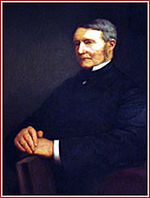John Hymers facts for kids
Quick facts for kids
The Revd Dr John Hymers JP DD FRS
|
|
|---|---|

John Hymers (1803–1887)
|
|
| Born | 20 July 1803 Ormesby, Yorkshire, England
|
| Died | 7 April 1887 Brandesburton, Yorkshire, England
|
| Nationality | British |
| Alma mater | St John's College, Cambridge |
| Known for | Analytic geometry |
| Scientific career | |
| Fields | Mathematician |
| Institutions | St John's College, Cambridge |
| Notable students | J. W. Colenso William Cavendish J. J. Sylvester John Couch Adams |
John Hymers (1803–1887) was a clever English mathematician and a church leader. He is best known for helping to start Hymers College in Hull, along with his brother Robert.
Contents
Early Life and Education
John Hymers was born on July 20, 1803, in a place called Ormesby in Yorkshire, England. His dad was a farmer, and his mom's father was a church leader. John went to school in Witton-le-Wear, Durham, and Sedbergh School.
In 1822, he got a special scholarship called a sizarship to attend St John's College, Cambridge University. This scholarship helped students who needed financial support. He worked hard and graduated in 1826 as the second wrangler. This means he was the second-best student in mathematics in his year, which was a huge achievement!
Career and Achievements
After graduating, John became a fellow at his college in 1827. This meant he was a senior member of the university staff. For several years, he was very good at teaching private students.
He became an assistant tutor at his college in 1829 and a full tutor in 1832. By 1838, he was a senior fellow, and in 1848, he became the president of the college. He also helped set the exams for the mathematical tripos (a tough math exam at Cambridge) in 1833–1834.
John earned his BD degree in 1836 and his DD degree in 1841. These are advanced degrees in divinity. On May 31, 1838, he was chosen to be a Fellow of the Royal Society. This is a very important group for top scientists in the UK.
John Hymers was distantly related to the famous poet William Wordsworth. He even had a painting of Wordsworth made for his college. He later gave some of Wordsworth's original writings to the college library.
Later Life
John Hymers never got married. In 1852, his college gave him a job as the rector (a type of church leader) of Brandesburton in Holderness, East Yorkshire. He lived there for the last 35 years of his life.
In 1857, he was made a Justice of the Peace for the East Riding of Yorkshire. This meant he helped keep law and order in the area. He stayed healthy until he passed away on April 7, 1887. He is buried in the churchyard at Brandesburton.
Legacy: Hymers College
John Hymers wanted to use his money to help young people get a good education. In his will, written on August 24, 1885, he left all his property to the town of Kingston upon Hull. He wanted them to use it to start a grammar school. The school's goal was "to train intelligence in whatever rank it may be found amongst the population of the town and port." This meant he wanted to help smart students from all backgrounds.
There was a small problem with the way his will was written, which made the gift legally difficult. However, his brother Robert, who was supposed to inherit the money, stepped in. Robert offered the town £40,000 (later increased to £50,000) to make sure his brother's wish came true. Because of this, Hymers College was able to open a few years later, in 1893.
Mathematical Works
Most of John Hymers's books were about mathematics. His work was influenced by new mathematical ideas from Europe. Here are some of his important books:
- Treatise on the Analytical Geometry of Three Dimensions, and of Curves of Double Curvature, 1830. This book was about studying shapes and spaces using math.
- Integral Calculus, 1835. In its second edition, this book introduced the topic of elliptic functions, which are special types of mathematical functions.
- Treatise on Conic Sections and the Theory of Plane Curves, introducing the new Method of Abridged Notation, 1837. This became a very important textbook for students.
- Theory of Equations, 1837. This book was about solving different kinds of mathematical equations.
- Differential Equations and the Calculus of Finite Differences, 1839. These are advanced topics in mathematics used to describe how things change.
- Treatise on Plane and Spherical Trigonometry, 1847. This book covered the study of triangles and angles, both on flat surfaces and on spheres.

